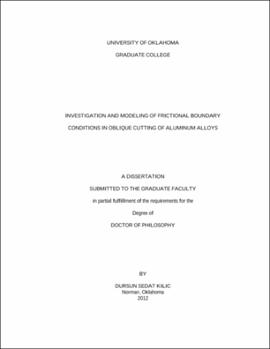| dc.contributor.advisor | Raman, Shivakumar | |
| dc.creator | Kilic, Dursun Sedat | |
| dc.date.accessioned | 2019-04-27T21:28:10Z | |
| dc.date.available | 2019-04-27T21:28:10Z | |
| dc.date.issued | 2012 | |
| dc.identifier | 99213532602042 | |
| dc.identifier.uri | https://hdl.handle.net/11244/318756 | |
| dc.description.abstract | Friction at the cutting tool interface has been studied for 60 years, yet an accurate model of friction is largely unavailable, especially in operations such as turning, where the interface is inaccessible due the continuous contact between chip and tool. A historical perspective of friction in turning is provided to better understand the purpose of this thesis. The contradictions arising from different frictional boundary condition assumptions in machining were analyzed. Experimental observations were substantiated in the light of the literature review. Friction conditions at the tool chip interface were found to be more complex than the simple models of seizure followed by sliding, which is accepted in most machining models. | |
| dc.description.abstract | This thesis investigated the surface topology of cutting tools in conventional turning operation, which is one of the oldest and common machining processes. Two different aluminum alloys Al-2024 and Al-6061 were used in turning experiments with carbide tools to define the frictional conditions as these alloys exhibited a wide range of frictional contacts at different machining conditions. Experiments were conducted using carbide cutting tools at a range of speeds, feed rates, and depths of cut, which are commonly utilized in industrial applications. | |
| dc.description.abstract | The analysis of tool chip interface at microscopic levels revealed further details of seizure and sliding zone formation. Newer techniques developed in microscopy and surface characterization were used to characterize the interface in a non-destructive manner. Scanning electron microscopy (SEM), surface profilometer and laser scanning confocal microscopy (LSCM) techniques helped us in the understanding of the frictional boundaries. | |
| dc.description.abstract | Analysis of SEM images obtained by turning experiments revealed three distinct regions whose topology is closely related to turning parameters. These different zones were named as primary sticking zone, sliding zone and secondary sticking zone. Furthermore, with the assistance of a developed computer code, the real area of contact and each different contact area were determined numerically. Therefore, this study is the first attempt in literature both identifies the frictional contact areas and computes their exact numerical values. | |
| dc.description.abstract | The SEM backscattering technique showed that the workpiece material behavior is different in the built up edge and sticking areas. This finding was especially used to identify the preliminary and secondary sticking areas. Thus, it has been showed first time that the deposited layers on frictional areas show different material characteristics. With the help of tool surface image analysis, area calculation algorithm, chemical composition identification, and earlier efforts cited in the literature, we proposed a stress-model which accurately predicted experimental normal and shear forces in oblique cutting of aluminum alloys for most tested conditions. | |
| dc.format.extent | 168 pages | |
| dc.format.medium | application.pdf | |
| dc.language | en_US | |
| dc.relation.requires | Adobe Acrobat Reader | |
| dc.subject | Metal-cutting tools | |
| dc.subject | Cutting | |
| dc.subject | Metal-cutting | |
| dc.subject | Machining | |
| dc.title | Investigation and Modeling of Frictional Boundary Conditions in Oblique Cutting of Aluminum Alloys | |
| dc.type | text | |
| dc.type | document | |
| dc.thesis.degree | Ph.D. | |
| ou.group | College of Engineering::School of Industrial Engineering | |
